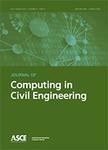版权所有:内蒙古大学图书馆 技术提供:维普资讯• 智图
内蒙古自治区呼和浩特市赛罕区大学西街235号 邮编: 010021

作者机构:Western Univ Dept Civil & Environm Engn London ON N6A 5B9 Canada Western Univ Dept Elect & Comp Engn London ON N6A 5B9 Canada Western Univ Western Acad Adv Res Dept Civil & Environm Engn London ON N6A 5B9 Canada
出 版 物:《JOURNAL OF COMPUTING IN CIVIL ENGINEERING》 (J. Comput. Civ. Eng.)
年 卷 期:2025年第39卷第3期
核心收录:
学科分类:08[工学] 0813[工学-建筑学] 0814[工学-土木工程] 0812[工学-计算机科学与技术(可授工学、理学学位)]
基 金:Natural Sciences and Engineering Research Council (NSERC) CGS-D Canada Research Chairs program Western Academy for Advanced Research (WAFAR) at Western University
主 题:Few-shot learning Prototypical networks Image transformation Damage classification Concrete Asphalt
摘 要:The application of machine learning (ML) as an apparatus for structural health monitoring (SHM) has become increasingly prevalent recently as the domain moves toward autonomous structural inspections. Although significant work has been conducted to integrate ML in SHM, many domain-specific issues adopting these technologies are still prevalent. For instance, ML is characterized as a data-intensive technique, requiring a significant number of samples to properly train a new model which are often unavailable in SHM applications. Furthermore, the generalization of these models to new categories of damages and structural and material types results in inferior damage classification. Therefore, to address the scarcity of data within SHM, few-shot learning (FSL) models, such as prototypical networks, have been recently explored as they are capable of training accurate classification models with limited images. However, the use of limited data results in model overfitting and may not adapt well to novel classes of data originating from new material and structural sources. In this paper, the effect of several image transformation techniques on the performance of a prototypical network is investigated concerning surface-level damages for concrete and asphalt structures. The effects of intramaterial data sets (data sets derived from the same material type), and intermaterial data sets (data sets derived from different material types) are investigated to understand and quantify the domain adaptation of these models. It was demonstrated that for k2, histogram equalization, logarithmic transform, and power transform performed marginally better (1%-5% for both material scenarios) than standard grayscale images when training the chosen prototypical network. The use of phase stretch transform and histogram equalization provided a better reduction to overfitting for both material scenarios (1%-5% and 1%-3%, respectively) when compared to grayscale, further demonstrating the effectiv